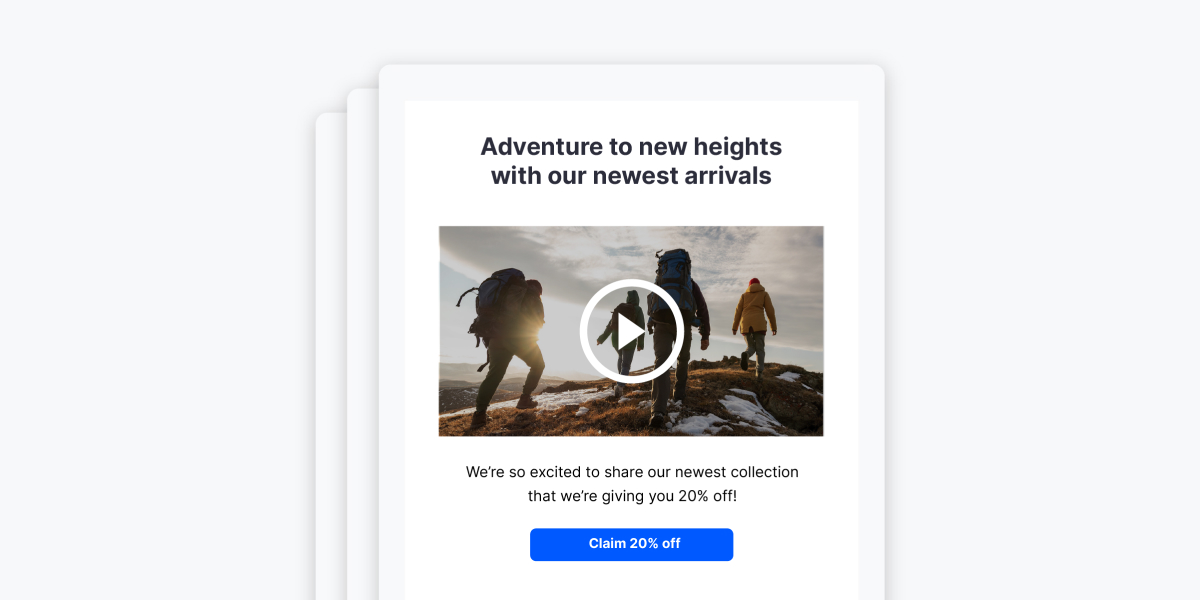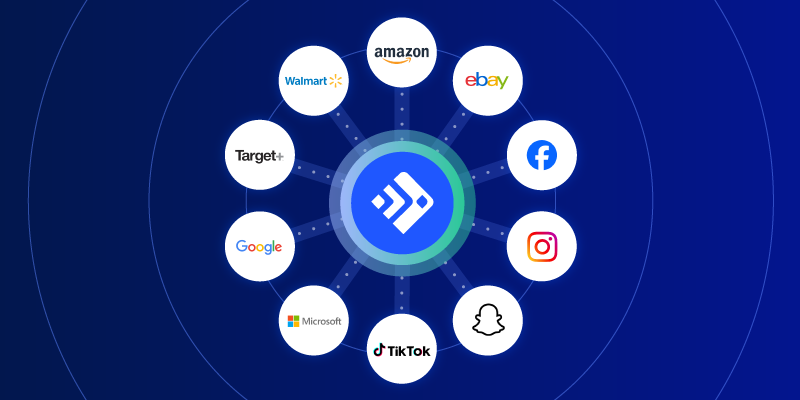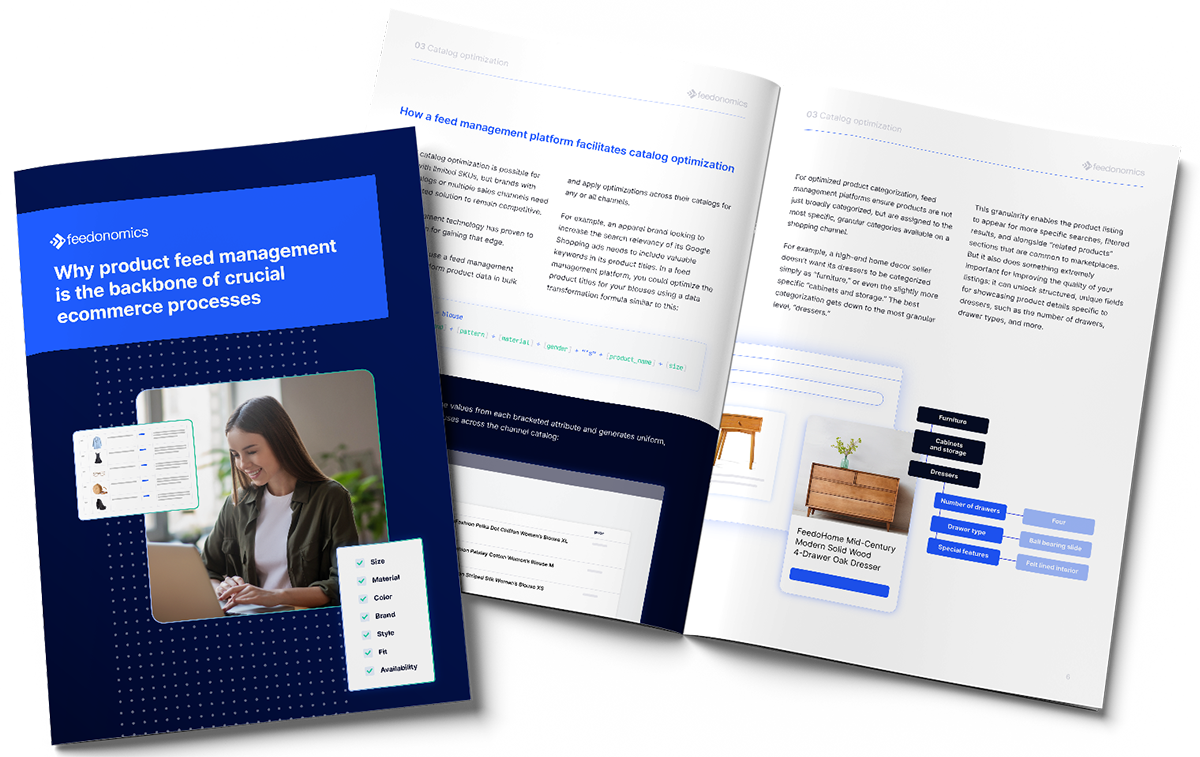Ecommerce sellers expend a lot of time, money, and brainpower encouraging customers to engage with their brands online. The successful ones know not to let that initial effort go to waste, and they use remarketing to create more impactful campaigns based on what they have learned about their customers.
Remarketing is widely regarded as a cost-effective way to increase conversions because it allows you to share more relevant content with an already-interested audience.
In this blog, we show you how to succeed with remarketing on SMS, email, and Google dynamic remarketing ads using sound strategies for branding, campaign optimization, and feed management. However, you should know that many marketplaces, social commerce platforms, and search engines also have remarketing tools for you to explore.
This remarketing blog has been written with help from our partners at BigCommerce, Revel Interactive, and adQuadrant as part of a series about how to win on a variety of key shopping destinations:
Winning remarketing through SMS, email, and Google dynamic remarketing ads
Remarketing through SMS and email involves re-engaging customers who have opted in to receive messages from your brand. By leveraging user data, such as browsing history or abandoned carts, you can send personalized messages directly to their phones or inboxes, offering them targeted promotions, reminders, or product recommendations.
“Email and SMS marketing allow brands to have a direct line of real-time communication with customers. Because users opt in (therefore they’re vetted and engaged), there’s a one-two punch of efficiency that other marketing channels struggle to match. Email and SMS can be particularly effective for exclusive product or sale launches because you can get your message across immediately.”
SMS and email have many similarities, so for brevity, we’ve lumped them together throughout this blog and highlighted how they differ when applicable.
On the other hand, Google’s dynamic remarketing ads enable you to show shoppers products they’ve already engaged with (or related products) on a wide range of websites, apps, and videos across the Google Display Network.
Google identifies who to display these ads to using a remarketing tag, aka a pixel, placed on your website, which tracks users who visit and adds them to your remarketing list to show them tailored ads as they continue to browse the web.
With that being said, let’s jump into the branding strategies that help your brand and products stand out.
Branding on remarketing channels
SMS and email branding
Play into your channel’s format
SMS messaging should be concise and to the point, given its character limitations and the immediacy of the platform.
In contrast, email is more flexible, allowing you to use more dynamic content, multiple calls-to-action (CTAs), and longer messaging.
“For SMS you should be pretty concise and keep it plain text, keep it easy. I think people who sign up for texts want to just consume it and go—they're on their phone, they're on the go. Whereas with email, people want more information and a bit more of an explanation.”
Keep it simple
Ensure that both your email and SMS content is optimized for mobile devices. This includes formatting emails so they display correctly on various email clients, and ensuring SMS messages are clear and actionable on small screens.
In emails, large images or overly complex designs can lead to slow load times or display issues. Focus on creating visually appealing yet functional designs that align with your brand and ensure a smooth user experience across all devices.
“You can still have an interesting email that doesn't have moving parts or some crazy design that screams at you the moment you open it. You can create something that is beautiful and designed correctly, but is still responsive and easy to interact with…something that's not going to cause their computer to overheat or their phone to explode.”
Lean into personalization
Personalization is key to effective branding in both SMS and email. Avoid generic messaging by segmenting your audience based on their preferences and behaviors (more on this later).
Sending different messages to customers based on their past purchases or engagement history makes the content more relevant and increases engagement.
“One common branding mistake is a lack of personalization, which usually comes down to throwing too many people into the same group. What I want to see is going to be very different from what my wife wants from the same brand.”
Be consistent across your channels
Ensure your email, SMS, and remarketing ads are in sync with other marketing channels, such as your website, social commerce channels, and the marketplaces you list on.
Consistency across all channels reinforces your campaign’s impact and helps ensure your audience receives your message, even if they miss it on one channel.
“As your email and SMS channels capture valuable first-party data, it's essential to share this data with your paid channels. By creating segments within your email service provider and leveraging platforms like Meta to generate lookalike (LAL) audiences and exclusions, you can amplify your targeting precision. The key is to ensure cohesion across all channels in terms of messaging, design, and deployment.”
Branding with Google dynamic remarketing display ads
Given that dynamic remarketing ads serve personalized product recommendations to individual customers, it’s important to balance this personalization with your overarching brand message. The look and feel of every ad should remain unmistakably yours—this includes using your brand’s colors, fonts, and logos consistently. Consistency helps build brand recognition and trust, making your customers more likely to engage with your ads and return to your site.
The dynamic nature of these ads allows you to personalize copy based on what the user has previously viewed, but it’s still crucial to write ad copy that reflects your brand’s voice while addressing the customer’s specific needs or interests.
Incorporating strong CTAs that reflect your brand’s unique selling propositions can effectively guide users toward taking the next step, whether it’s making a first purchase, signing up for a newsletter, or returning to complete a purchase they left in their cart.
Finally, don’t be afraid to exclude certain ad formats from your campaigns if they end up diluting your branding. For example, if you’re selling high-end products, you might avoid using overly simplistic text-only ads or banner ads that could conflict with your luxurious image.
Creating winning remarketing campaigns
Incentivizing data-sharing and opt-ins
Use incentives such as discounts, early access to products, or exclusive offers to encourage customers to share their phone numbers and email addresses. The more first-party data you collect, the better you can personalize your campaigns and improve targeting. It’s also a good idea to get your customers to opt in to both email and SMS messages at the same time, which increases the chances you can stay in contact in case they unsubscribe from one or the other.
“It's crucial to remain visible for email capture even if initial interest isn't sparked. This could involve using teaser prompts, footer captures, or capturing emails during the checkout process, especially for abandoned carts. By continuously refining your strategies and remaining visible throughout the customer journey, you maximize opportunities to capture valuable email leads and drive engagement.”
Segmenting your audience
Segmentation is the act of dividing your audience into smaller groups based on their behaviors, preferences, or past interactions with your brand.
Ultimately, the goal with segmentation is to offer them a personalized experience that is better than generic and broader messaging. Depending on the platform, this can include using dynamic content that changes based on the recipient’s previous purchases or interests.
“Segmentation and list health are key. A stale list that is weighed down by inactive subscribers can make it difficult to gauge what is and isn’t working. Focus your email strategy, including testing, around segments that are engaged to get clearer learnings faster. There is always the opportunity to re-engage lapsed customers as well.”
For example, for an email campaign, you could segment your audiences based on behaviors like “recent buyers,” “repeat customers,” and “cart abandoners,” and send product recommendations, exclusive offers, and a reminder message with a discount code to each group respectively.
Refining your cross-promotion strategy
Use email and SMS together in integrated campaigns to reinforce promotions and offers. For example, an email might introduce a discount, while a text message could serve as a reminder or offer an additional incentive for acting quickly.
“Email and SMS marketing should be utilized with other marketing channels because they provide first-party data that can help build and facilitate similar LAL audiences on search and social. You also can target them directly to help ensure a message is seen on another channel. An example of this would be early access to a sale—you’d email your VIP customers and also target them specifically with social ads.”
A/B testing
Maximizing the effectiveness of your campaigns involves continuous testing and optimization.
“A/B testing allows you to compare different versions of your emails or SMS messages—with variables like subject lines, content, CTA buttons, and sending times—to gain valuable insights into what drives engagement and conversions. A/B testing empowers you to make data-driven decisions, optimize your campaigns for better results, and ultimately enhance the overall performance of your email and SMS marketing efforts.”
Timing
Have you ever been spam-called at midnight? Unlikely. That’s because even those pesky scammers know the importance of timing.
The timing of your emails and SMS messages can significantly impact their effectiveness. Test different days of the week and times of day to find the optimal send times for your audience. Using tools that optimize send times based on individual engagement behaviors can remove much of the guesswork and maximize the impact of your campaigns.
Implement frequency caps to avoid overwhelming your audience with too many messages. While email campaigns can be more frequent, SMS should be used sparingly to avoid being perceived as intrusive. By controlling the frequency, you can maintain a positive brand impression and reduce the risk of unsubscribes.
“Different types of content may perform better at specific times of the day based on audience behavior and preferences. For example, sales emails might be more effective sent early in the morning when subscribers are checking their emails before starting their day, whereas blog articles may garner higher engagement when sent in the evening as people wind down and have more time to read.”
Monitoring metrics
The significance of metrics in email marketing can vary depending on the brand and the specific goals of the email content. For instance, if you’re sending informative blog emails, your primary goal might not be immediate sales, but rather to drive engagement and readership. In this case, Spencer recommends monitoring click-through rates, as they indicate the level of interest and interaction with your content.
On the other hand, for product launch emails or promotional campaigns, metrics such as placed orders, open rates, and click rates are more directly tied to revenue generation and conversion.
“Monitoring metrics like unsubscribe rate and delivery rate is essential for maintaining a healthy email and SMS marketing strategy, particularly for customer retention purposes. If you notice an increase in unsubscribes, it's crucial to evaluate your content planner and examine factors such as frequency and types of messages being sent. Collecting feedback from subscribers about their preferences can also provide valuable insights into areas for improvement.”
Optimizing your product feeds for SMS, email, and display remarketing
A product feed is a structured file that contains all your product details, like titles, images, prices, availability, and SKU codes.
Product feeds are essential to the success of your remarketing campaigns, as they serve as the foundation for platforms like Google to deliver personalized product ads to users.
Here are some best practices for optimizing your product feeds for your remarketing campaigns:
- Make sure your product feeds are accurate and up-to-date, so customers don’t try to purchase out-of-stock products, and so your account remains in good standing on platforms like Google.
- Ensure your product titles, descriptions, and other attributes are optimized. This means including crucial product features that can push your customers to make a purchase.
- Use custom labels to customize your strategy. For example, you can use them in the feed to identify new arrivals, price drops, and best sellers to create more targeted campaigns for SMS, email, and Google.
- Customize your feeds based on the channels you’re listing on. For example, you may want the title to be an exact match to the website title for SMS marketing, but to use a keyword-rich title for Google.
- For Google display ads, take advantage of supplementary feed attributes that allow you to specify landing pages, product titles, and product recommendations.
Leveraging a feed management platform
A feed management platform is invaluable for optimizing and managing your product feeds across dynamic remarketing ads, SMS, and email campaigns—especially if you have a large product catalog.
You can automate the process of updating and transforming your product data, ensuring that your feed is always accurate, optimized, and consistent across all channels. Conversely, you can automate how your product information should differ depending on the channel it is listed on.
You can use custom labels within your platform to segment and customize your feeds for different campaigns, helping you deliver personalized and relevant content to your audience.
Additionally, you can use your platform to enhance your testing strategy. You may choose to test with a single product type, many product types, or even the entire product feed. Once you split your products into groups, you can use custom labels in the feed to track their performance.
Future trends in remarketing on SMS and email
Conversational messaging
Spencer sees conversational messaging—a two-way dialogue between you and your customers—growing in importance as an SMS strategy.
Conversational messaging provides a convenient channel for contacts seeking assistance, offering easier access than calling or emailing.
“The higher engagement level in conversational messaging fosters more meaningful interactions and can lead to increased customer satisfaction and loyalty. Therefore, investing in conversational messaging capabilities and actively managing and optimizing these interactions can greatly enhance the effectiveness of SMS marketing campaigns.”
Richer media content

Additionally, Spencer believes that the integration of rich media content into email marketing is a growing trend. Video, especially short-form video, has proven to be highly engaging and effective in conveying messages, often outperforming other content types.
“Video content can capture attention, evoke emotions, and deliver complex messages in a concise and visually compelling manner, ultimately leading to higher engagement and conversion rates.”
Deeper personalization
“Personalization has always been important in email and SMS marketing, but we believe we’ll continue to see this become even more important as AI develops to help customize emails and SMS messages to individual subscribers based on their behaviors.”
Feedonomics can help you optimize product data for your remarketing campaigns.

Muhammed is a content marketing specialist creating informative content to help ecommerce professionals solve industry challenges and stay ahead of the curve.












